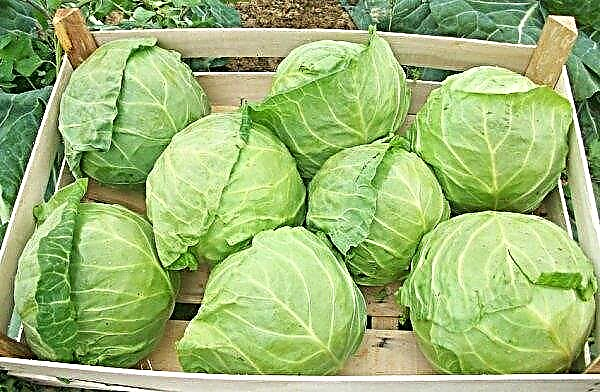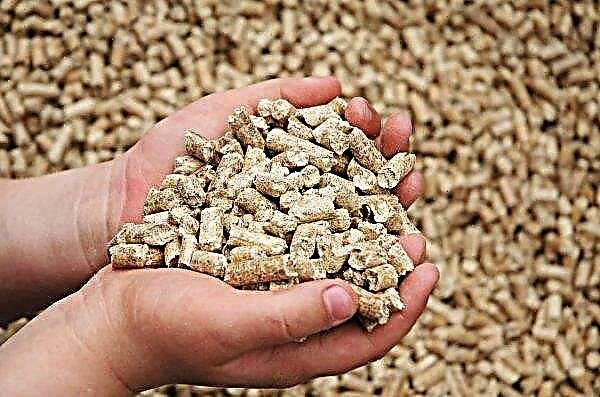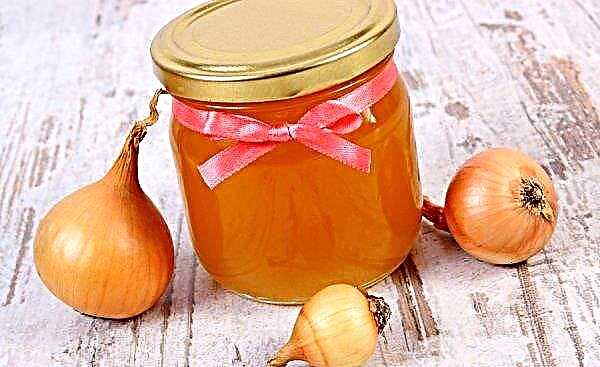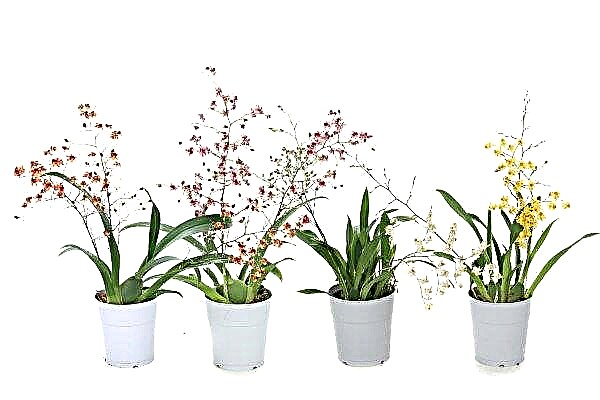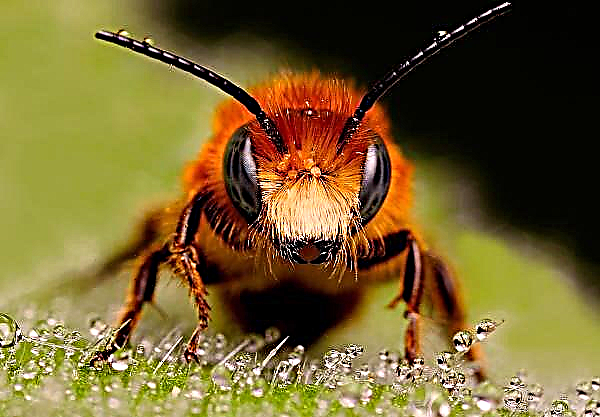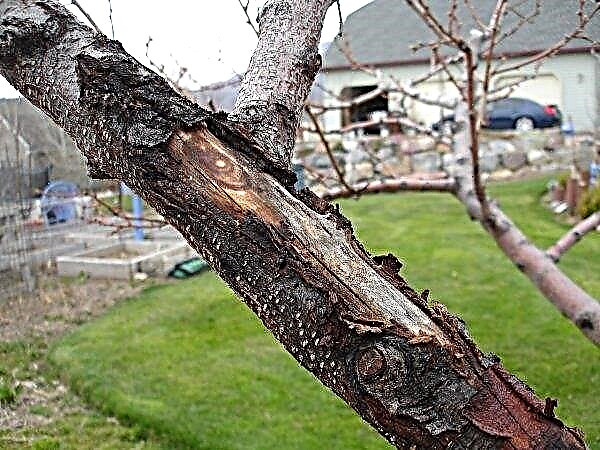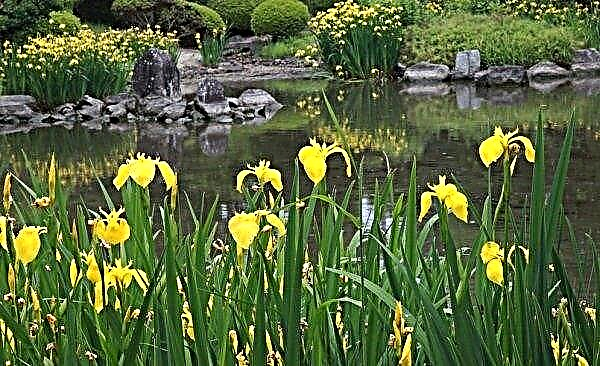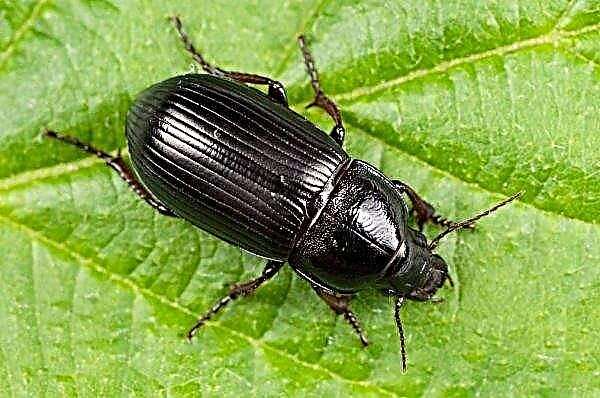Plants such as roses are extremely popular because of their beautiful flowers and delicious aroma. Landora rose is a charming bright yellow flowers with pearly dark green leaves. The features of the variety and its care will be described below.
Description and characteristics of the plant
Landora is a hybrid tea rose. It is believed that this is the most successful yellow hybrid in recent years. Landora has superbly shaped flowers that do not fade for a long time. She blooms in several series throughout the season. Stems of medium size, strictly vertical, with spikes. Needs regular watering. Suitable for growing sunny areas with well-drained soil, rich in nutrients.
Did you know? Some gardeners believe that music, such as Beethoven’s works, influences rose growing. But in fact, there are no convincing results of such studies yet.
Basic Feature:
- registered species name: Sunblest;
- trade name: Edelrose Rosen Tantau® Landora® Sunblest;
- synonymous name - Tanya (Tania);
- breeding year: Germany, 1970;
- year of registration: 1971;
- breeder: Mathias Tantau, Jr. (Mathias Tantau, Jr.);
- group: tea rose hybrid.
- color: dark yellow;
- color code: LY;
- flower type: full, double;
- flower: a very large cupped of 30-40 petals of a pointed shape;
- shape: round;
- the average diameter of the open flower: 12 cm;
- aroma: fruity, light, almost absent;
- flowering: from June to October.
Bush Characteristic:
- height: from 90 to 130 cm;
- bush width: 60 cm;
- foliage: light green with a serrated edge;
- spikes: prickly;
- application: for decorating flower beds;
- frost resistance: –23 ° С;
- disease resistance: immune.
Features of planting and growing
Rose fans have a lot of tips and tricks on how to properly grow these flowers. In order for the bush to feel great, it is important to create conditions similar to those indicated by the variety producer.
Did you know? Most likely, rose cultivation began in Asia about 5,000 years ago. Now in the world there are about 13,000 registered varieties of these flowers.
The timing
For planting in the garden, roses are acquired. They can be immediately planted in the ground. Landora is planted year-round, with the exception of the cold season, but it is better to do this in early spring at the beginning of the growing season - it can be April or early May. The optimum air temperature in this case is not lower than + 20 ° С. Varietal bushes of a non-hybrid type are planted in late autumn after falling leaves.
Optimal conditions
For a successful planting and cultivation of roses Landora need optimal conditions.
You will be interested

Bushes necessarily need such factors:
- sun at least 4-6 hours a day;
- nutrient rich soil;
- good drainage from the roots;
- a sufficient amount of air around each stem;
- mulching the roots to retain moisture and obstruct the growth of weeds;
- deep but infrequent watering;
- regular pruning of dry branches and faded buds.
Seat selection
Roses grow well on different types of soils. But during use, the soil is depleted, and when planting, fertilizer must be applied. Soil acidity can be around 5.6–7.3 pH.

Basic rules for choosing a place to land:
- If you have already grown roses where you are going to plant Landora - replace the soil in the planting pit to a depth of 60 cm.
- Choose a well-ventilated sunny area. The duration of full sun on it should not be less than 4 hours a day.
- In particularly hot climates, roses should be protected from the midday sun. In cold climates, it will be right to plant a bush next to a fence or wall facing south or west to minimize the risk of freezing in winter.
- Avoid areas where trees give a dense shadow.
- The soil should be rich in nutrients and well drained. In heavy clay soil, mix compost, peat moss and other organic matter to improve nutrition and drainage. In dry sandy soils, add compost to keep moisture at the roots of the plant.
Did you know? Sharp thorns on the stem of a rose bush look like hooks used by climbers. Their purpose — protecting the stem from herbivores.
Step-by-step landing process
The size of the hole in which you plant the Landora rose is one of the key factors that contribute to good bush growth. If you are planting roots, the pit should be deep and wide enough to accommodate them and provide good drainage. Roses do not like getting the root system wet.

Rose planting step by step:
- The day before planting, you can treat the roots of the rose with a growth stimulant. Even without such treatment, they still need to be soaked in water a few hours before planting.
- Make a pit 50 × 50 cm in size. When planting several roses, pits are made at a distance of 60 cm from each other.
- Add rotted manure to the bottom of the hole (100 g / m²).
- Lay a layer of new soil with a thickness of 10 cm. Some gardeners lay a banana in the pit to provide the bush with potassium. The roots of the rose should not be in contact with manure. Some bone meal is also added to the pit as a source of phosphorus.
- Place the bush in a pit and cover it with soil.
- Pour using 8-10 liters of water per bush, and compact the soil around the trunk.
- When the soil settles down, add more earth around the trunk to the point of grafting the bush. This will protect the root from drying winds or frosts.
Important! Within 3 months after planting, the bush cannot be mulched.
For best results, plant roses on a calm cloudy day: planting on a hot sunny day can cause stress in the bushes.
Care Tips
Care for the Landora rose consists in the timely implementation of the main procedures - this is watering, fertilizing, cultivating, weeding, pruning, shelter for the winter. We will talk about their features further.
Watering
During the first year of growth, the Landora bush is watered once a week, depending on the weather. The norm for 1 plant is 12 liters of water. Watering should be deep, as the roots of the rose go deep into the soil. It is not advisable that water get on the leaves during watering.

Top dressing
After planting during the growing season, roses are fertilized several times:
- the first time - in the early spring, as soon as the leaves appear;
- the second - after the first wave of flowering;
- the third - after the next flowering wave.
Stop fertilizing roses by the end of summer. This is necessary so that the stems have time to prepare for wintering. Then, each spring, fertilizer for roses is applied under the bush at the rate of 100 g / m². Regular top dressing will remain the same. Unplanned top dressing is carried out if the growth of the bush slows down.
Loosening and weeding
Loosening is carried out after each watering. Its purpose is to weaken the soil in order to provide better conditions for the development of roots. Loosening is necessary to a depth of 8 cm, but so as not to touch the roots. The process of loosening is also combined with weeding and weed removal. If the root zone is covered with mulch, which prevents the growth of weeds, then the loosening procedure will not be necessary.

Pruning
The purpose of pruning is to give each stalk enough air to prevent rot and disease. Pruning is carried out just above the places where the branches form. The incision is made obliquely at an angle of 45 °. In late autumn and spring, dead stems are pruned. Leave about 8 stems, shortening them by 1/3 - this is useful for further growth in the new growing season. In summer, be sure to cut off the faded heads to stimulate the next flowering wave.
Important! When planting branches, trim not allowed, but after a year they are necessarily cut (in March) to enhance growth.
Shelter for the winter
In November, the bush is spudded with earth to a height of 15 cm to protect the branches from frost. Landora is quite frost-resistant (up to –23 ° С), so in regions with warm winters it is not always spud. Created hill is removed in March, and in regions with a long winter - in April.
Growing difficulties
Landora is resistant to disease, therefore, does not need special annual treatments.
However, under adverse growing conditions, it can be attacked by the most common rose diseases, including:
Powdery mildew is especially active in the summer. Its development requires hot and dry days, as well as wet and cool nights. Symptoms of the disease are twisted leaves and a white coating on them. To avoid the disease, water the plants in the morning at ground level, without falling on the leaves. Pruning a bush to allow air to circulate through the foliage also helps prevent this problem.
Black spotting is characterized by black dry spots on a leaf plate. This disease can be prevented in the same way as in the case of powdery mildew, improving air circulation around the plant and conducting watering at ground level. Leaves affected by the disease are removed, and the bush is sprayed with Bordeaux fluid. Insects that like to eat rose bushes include aphids, sawflies, and spider mites.
Almost all of these pests can be controlled by spraying with a solution of insecticidal soap. Thus, the Landora rose is a whimsical flower, however, correctly and on time performed procedures for planting and growing this plant will give you the opportunity to enjoy its beautiful and fragrant flowering. In addition, Landora tea rose petals have benefits for human health.


